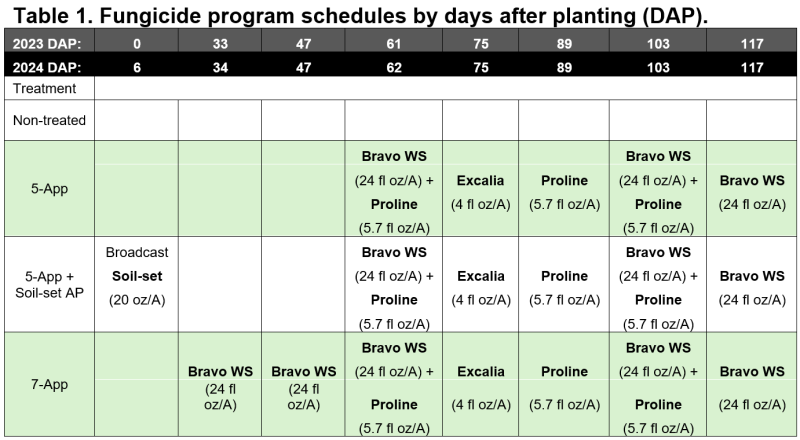Rebecca Barocco and Ian Small, North Florida Research and Education Center-Quincy
Peanut early leaf spot, late leaf spot, and stem rot (a.k.a white mold) are economically important fungal diseases that survive within fields between seasons and can cause significant yield loss if not well controlled (Figure 1). These leaf spot pathogens only cause diseases on peanut and are usually well managed with fungicides. However, the optimal time to begin applying fungicides is not always clear, and stem rot can be difficult to control. Time of disease onset can depend on many factors that affect the ability of the pathogens to survive between seasons and to reach and infect plants. These factors can include cultural management practices, field characteristics, and weather patterns.

Figure 1. Peanut fungal diseases known to cause economic yield loss that survive within fields between seasons. Photo credit: Rebecca Barocco, UF/IFAS
–
Decisions for field management in the winter between peanut seasons are diverse among producers depending on the unique needs of their farm operations and field environment. Although rotating with cotton or corn is ideal for peanut disease and soil health management, many growers may be under economic pressure to reduce intervals between peanut production.
–
Broad & Long-term Goals
With the aid of sensor-based modeling and field studies, our goal is to learn how winter management practices, field characteristics, and weather patterns affect pathogen survival in soil and initial dispersal from the soil to peanut (Figure 2).
Specific objectives:
- Identify winter management practices that delay and reduce disease epidemics without compromising plant growth and yield.
- Develop a risk model for time of disease onset to support decisions on the optimal time to begin a fungicide program.
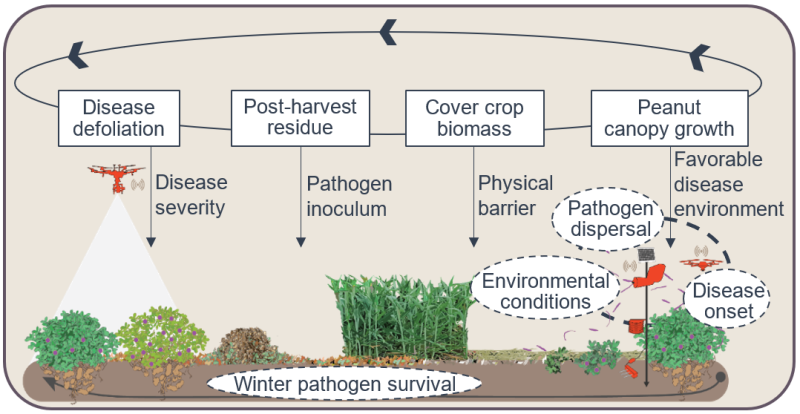
Figure 2. Diagram showing the framework for sensor-based modeling with potential factors affecting the behavior and life cycles of peanut pathogens that survive within fields between seasons. (Artwork: Rebecca Barocco using original photos in Adobe Illustrator)
–
Post-harvest residue management with a biostimulant
UF/IFAAS researchers started their research with the hypothesis that a soil biostimulant product could be used to facilitate the breakdown of postharvest residue and thereby reduce leaf spot pathogen survival. We chose to study the product Soil-Set® (Alltech®), which is a combination of bacterial metabolites, enzymes, and micronutrients marketed to break down tissue residue and promote plant and microbial soil health. We conducted a field trial with peanut ‘GA-06G’ to determine the effect of a broadcast application of Soil-Set® over peanut residue left after harvest from the previous season on diseases and yield. Fungicide programs, including a delayed 5-application program and standard 7-application program, were compared as subplot treatments (Table 1). In this trial, we included a litterbag study to monitor the decomposition rate of postharvest residue in non-treated plots.
–
Primary findings for Soil-Set® with peanut ‘GA-06G’
-
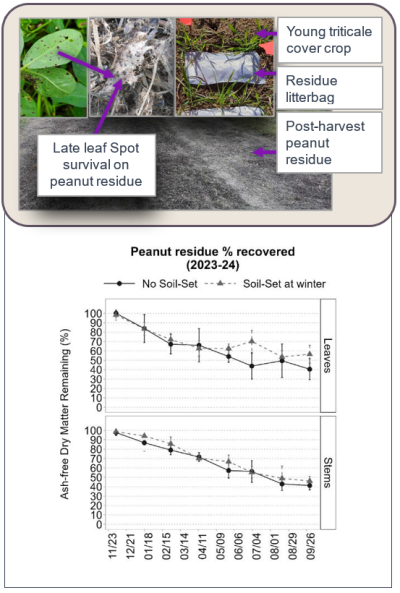
Figure 3. Litterbag peanut residue decomposition study conducted in the Soil-Set trial non-treated plots. Photo credit: Rebecca Barocco.
Soil-Set did not increase post-harvest residue decomposition rate (Figure 3).
- Soil-Set did not reduce leaf spot and defoliation (Figure 4) or stem rot (not shown).
- Soil-Set did not affect yield in fungicide treated plots (Figure 5, Table 2).
- Higher yield in non-treated plots by an average of 1,011 lbs/A but only in the 2024 season (Figure 5).
Conclusion: Soil-Set® was not effective as a tool for peanut disease management as applied in the production system of this study.
Discussion: More research is needed to evaluate soil microbial stimulants for integrated plant health and disease management systems. Only one type of biostimulant product was tested. The ability to stimulate and harness the benefit of soil microorganisms is a rapidly growing area of research and may improve with future product development or novel uses of existing products.
–
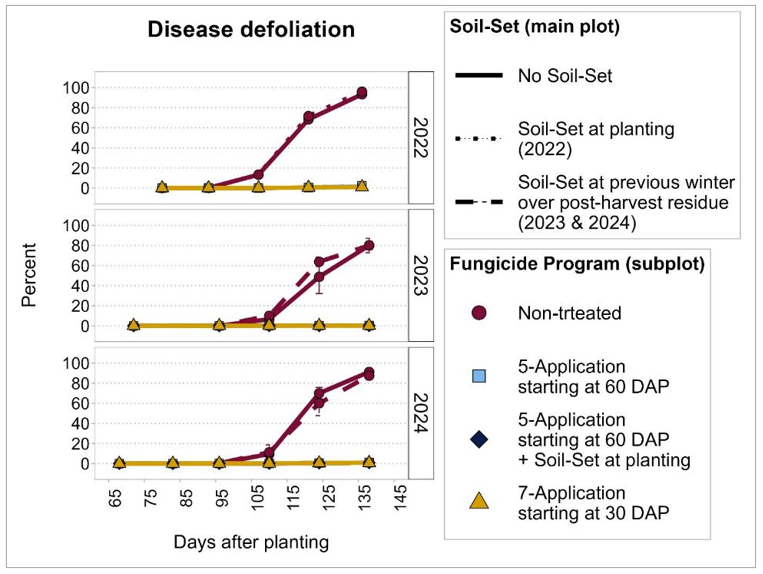
Figure 4. Disease defoliation progress by days after planting (DAP) primarily caused by leaf spot in the Soil-Set® x Fungicide trial conducted at the UF/IFAS NFREC in Quincy, FL.
–
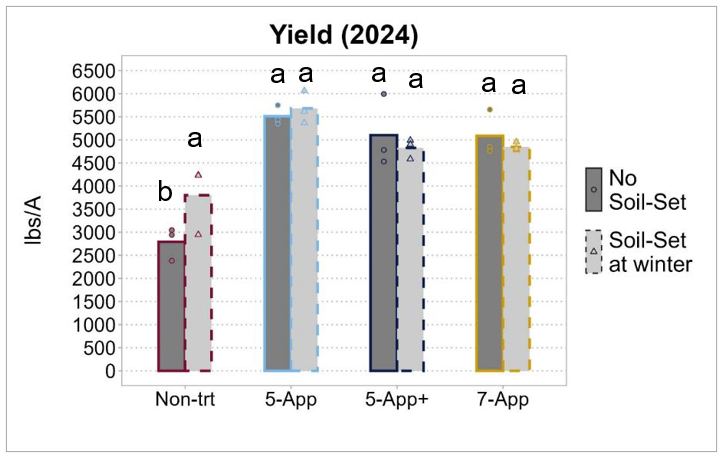
Figure 5. Yield by treatment in the 2024 Soil-Set® x Fungicide trial with a significant interaction (P = 0.03). Bar plots with the same letter within each fungicide program are not significantly different according to Tukey’s Honest Significant Difference test (α=0.05). Circle and triangle points within each bar plot are individual plot values for the respective treatment.
–
Cover crops and bailing residue for hay
We are now moving towards studying the interactions of cover crops and bailing residue on peanut health and diseases (Figure 6). These trials will begin in the 2025-26 winter.
After peanut harvest, some growers may opt to bail peanut residue for hay. This practice can have economic value by either selling or feeding the hay. Removing the residue from the field may have an additional benefit of reducing diseases the following season. Some of the pathogen inoculum on the foliage and stems may be removed. However, removing crop residue also removes valuable nutrients from the field. Additionally, much of the foliage infected by the pathogens that cause early and late leaf spot diseases or the sclerotia of the pathogen that causes stem rot are likely to drop to the soil prior to harvest and may not be collected when bailing for hay.

Figure 6. A diagram of within-field peanut late leaf spot pathogen survival and disease infection cycle in the context of winter field management trials (Hay x Tillage and Soil-Set®) with a triticale cover crop at the UF/IFAS NFREC in Quincy, FL. Early leaf spot was observed before late leaf spot in these fields. Photos used for diagram purposes. Photo credits: Cat Wofford, UF/IFAS Communications Photography and Rebecca Barocco, UF/IFAS.
–
We hypothesize that trade-offs will vary depending on winter field management decisions. We aim to help answer a few questions:
–
-
Can cover crops reduce or delay peanut diseases, and is the effect proportional to cover crop biomass?
– -
How effective is the nutrient release from peanut post-harvest residue on the subsequent cover crop growth?
– -
Do management systems that include winter cover crops have more of a long-term benefit by leaving, rather than bailing, the residue in the field?
– -
Conversely, do management systems that do not include cover crops benefit more by removing residue for hay income and/or reducing some of the pathogen inoculum?
–
A preliminary study showed promise using cover crops for leaf spot management (Figure 7), but results were observed with severe deer grazing and low to no yield. Better quality trials are needed before making conclusions from this study.
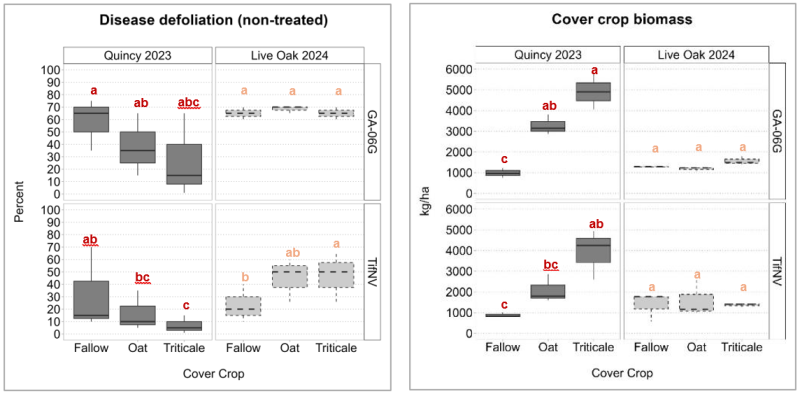
Figure 7. Final percent disease defoliation in Quincy 2023 (140 days after planting) and Live Oak 2024 (140 days after planting) (left) in comparison to cover crop biomass collected just before termination with herbicide (right) among crop system treatments (cover crop and cultivars GA-06G &TifNV-High OL). Boxplots with the same letter among all six crop systems (cover crop and cultivar) within a field site are not significantly different according to Tukey’s Honest Significant Difference test (α=0.05).
–
If you are interested in these research questions or would be willing to cooperate with us on these topics, please reach out to Rebecca Barocco or Ian Small.
–
Acknowledgements
We thank our sponsors at University of Florida Institute of Food & Agricultural Sciences, Florida Department of Agriculture & Consumer Services, National Peanut Board, Florida Peanut Producers Association, Florida Peanut Federation, and IoT4Ag NSF Research Center for funding this research.
We give a special thanks to Chuck Dickson, Ethan Bolton, Kelly O’Brien, Jimmy Hsu, and the farm crews at the North Florida Research and Education Centers (Quincy and Live Oak) for advice and assistance with managing peanut field trials and data collection and to our collaborators Kaile Zhang, Hui-Ling (Sunny) Liao, Nicholas Dufault, Dan Anco, Ramdeo Seepaul, Gueorgui Anguelov, Cheryl Mackowiak, Zane Grabau, Sheeja George, and Alina Zare.
- Managing Peanut Health and Diseases in the Winter - January 31, 2025
- Bridging the Gap: Empowering Youth with Ag-Tech Skills - July 16, 2024
- Time to Protect your Cotton from Premature Defoliation due to Foliar Diseases - July 30, 2021

